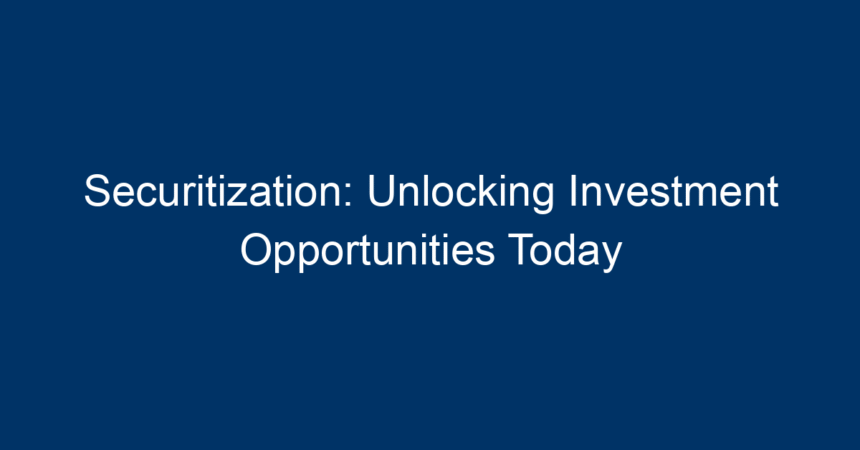In the ever-evolving world of finance, securitization stands out as a pivotal process that has transformed how assets are structured and how investors engage with them. By converting illiquid assets into securities, securitization provides a multitude of investment opportunities, enhances liquidity, and offers innovative risk management solutions. In this article, we’ll explore what securitization entails, its benefits, the types of assets involved, and how it ultimately unlocks investment opportunities for both individual and institutional investors.
Understanding Securitization
Securitization is the financial process of pooling various types of debt—ranging from mortgages to auto loans—and selling them as consolidated securities to investors. This practice not only helps in raising capital but also redistributes risk among market participants.
The Mechanics of Securitization
At its core, securitization involves several key steps:
- Asset Pooling: Lenders bundle financial assets—like mortgages or credit card debts—into a pool.
- Special Purpose Vehicle (SPV): This entity is created to isolate financial risk. The SPV purchases the pooled assets and subsequently issues securities.
- Security Issuance: The SPV sells these securities to investors. The cash flow from the underlying assets is used to pay interest and principal to investors.
- Credit Enhancement: Measures, such as insurance or subordination, may be employed to improve the security’s rating, thus making it more attractive to investors.
Why Securitize?
The benefits of securitization are substantial:
- Liquidity: It transforms illiquid assets into tradable securities, improving market liquidity.
- Risk Diversification: By pooling assets, risks can be spread among a larger group of investors.
- Access to Capital: Financial institutions can quickly convert assets into cash, enhancing their capital positions.
Types of Securitized Assets
Securitization can encompass a variety of asset classes:
1. Mortgage-Backed Securities (MBS)
Mortgage-backed securities are among the most common forms of securitization. They are created by pooling numerous home loans into a single security. MBS offers investors a chance to receive regular income generated from mortgage payments.
2. Asset-Backed Securities (ABS)
These securities are backed by various financial assets, excluding mortgages. Common examples include auto loans, credit card debt, and student loans. ABS provides investors with a unique opportunity to tap into consumer credit markets.
3. Collateralized Debt Obligations (CDOs)
CDOs pool bonds, loans, or other debt instruments and slice them into tranches that have varying levels of risk and return. This complexity allows both conservative and aggressive investors to find suitable investment options.
4. Credit Card Receivables
Credit card securitization involves pooling credit card debt and issuing securities backed by the payment streams from consumers. This type of securitization delivers attractive yields while also offering relatively predictable income streams.
The Role of Ratings Agencies
Ratings agencies play a crucial role in the securitization ecosystem. They assess the risk associated with the underlying assets and assign ratings that impact the desirability of the securities. A higher rating often results in a lower yield, while lower-rated securities offer higher yields to compensate for increased risk. Understanding these ratings is essential for investors looking to navigate the securitization landscape effectively.
Benefits of Investing in Securitization
Investing in securitized products presents numerous advantages:
1. Diversification
Securitized products allow investors to diversify their portfolios by gaining exposure to a wide array of asset classes without direct ownership.
2. Yield Enhancement
Many securitized products offer higher yields than traditional fixed-income investments, making them attractive options for income-focused investors.
3. Risk Management
Securitization allows investors to manage risk more effectively by selecting specific tranches that match their risk tolerance and investment objectives.
Risks Associated with Securitization
While securitization can unlock numerous opportunities, it’s essential to be aware of the associated risks:
1. Credit Risk
Should the underlying assets default, investors in securitized products may face significant losses.
2. Interest Rate Risk
Changes in interest rates can affect the performance of securitized assets, leading to fluctuations in their market value.
3. Complexity
The intricate structures of some securitized products can lead to misunderstanding and mispricing, particularly among less experienced investors.
Navigating the Securitization Market
1. Research and Education
Investors should invest time in understanding the specific types of securities available, as well as the underlying assets backing them. This foundational knowledge will facilitate informed decision-making.
2. Consult Experts
Engaging with financial advisors or analysts who specialize in securitized products can provide invaluable insights and guidance.
3. Diversify Across Types
Investors should strive to diversify their investments within the securitization space to mitigate risk and capitalize on different sectors of the economy.
4. Monitor Economic Indicators
The performance of securitized products is often tied to broader economic conditions. Keeping an eye on employment rates, housing markets, and interest rates can provide valuable context to your investments.
Conclusion: Harnessing the Power of Securitization
Securitization has proven to be a powerful tool in the modern financial landscape, unlocking investment opportunities that were once out of reach for many investors. By understanding its mechanics, recognizing the benefits and risks, and staying informed about market dynamics, investors can strategically navigate this complex field.
To make the most of what securitization has to offer, begin by deepening your knowledge and considering how these unique financial instruments can align with your investment goals. With the right approach, securitization could provide a pathway to enhanced returns and well-managed risk in your overall portfolio.
In today’s fast-paced investment climate, securitization is not just an option—it’s an opportunity waiting to be seized.




